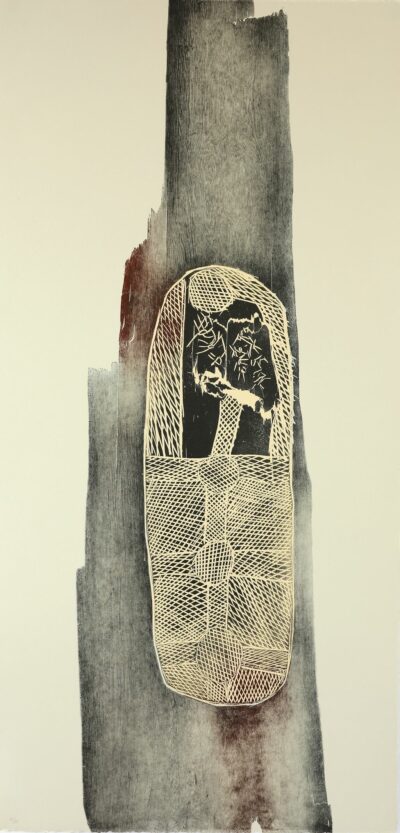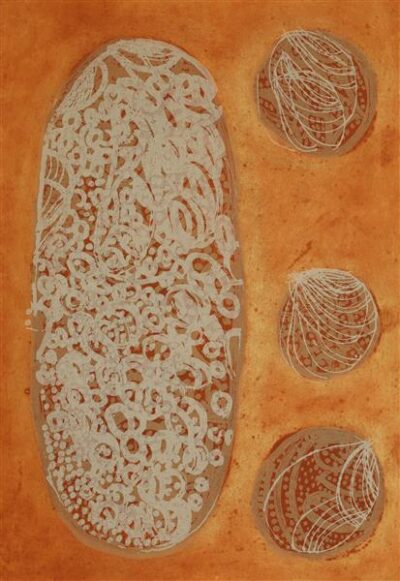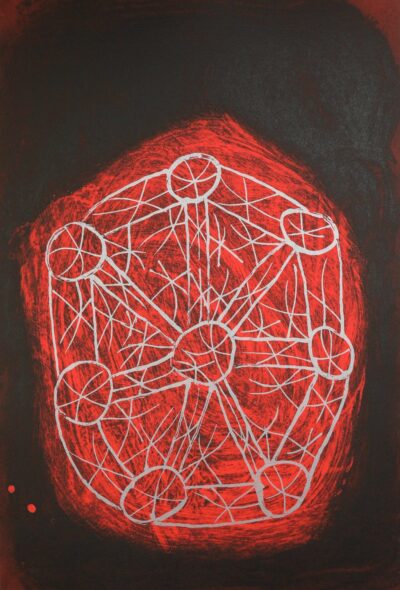mulku-wirrpanda
Homeland: Dhuruputjpi
Clan: Dhuḏi-Djapu, Dha-malamirr
Moiety: Dhuwa
A senior artist of the Dhuḏi-Djapu clan from Dhuruputjpi, in Eastern Arnhem Land, Mulkuṉ Wirrpanda was a classificatory daughter of the late Dhäkiyarr Wirrpanda and mother (by kinship) to senior artist and clan leader Djambawa Marawili.
Mulkuṉ painted Dhuḏi-Djapu miny’ji (sacred designs) that depicted her land at Dhuruputjpi, including the areas of Yalata and Darraŋgi. As the eldest and most knowledgeable of her clan, she was acknowledged as a leader, one of the few Yolŋu women to have this status. Mulkuṉ was an early practitioner of works without figurative imagery within the miny’tji (sacred clan design) – until recently restricted to ceremonial use – using natural earth pigments (ochres). She painted on bark, ḻarrakitj (memorial poles), yiḏaki (didjeridus) and was a talented carver, weaver and print maker.
From 2012 she began to explore lesser-known edible plant species, the nutritious food that she grew up on, which she feared were being forgotten by younger generations. In stark contrast to today, in those days old people lived for a long time without illness. This exploration coincided with landscape painter John Wolseley’s interest in returning to Yilpara, after the two artists had met during the Djalkiri project of 2010, when they spent an extended period exploring the botany of Blue Mud Bay. Wolseley spent a week at Yilpara with Mulkuṉ in May 2012 and again at Yirrkala in June 2013, with further extended annual visits every year until her death in 2021. Their exhibition Mulkun Wirrpanda & John Wolseley: Two old artists looking for food presaged their collaboration Miḏawarr/Harvest, a joint exhibition at the National Museum of Australia in October 2017 that toured to Darwin and Melbourne. Her subsequent paintings of maypal (shellfish), which inhabit the coastal waters of the Northern Territory culminated in an exhibition at Salon Art Projects in Darwin.
In 2019, Wolseley and Mulkuṉ explored extended ideas of maypal, which by definition includes some larvae that bore into wood. This led into her final, significant project on the theme of termite ecosystems, which forms the focus of her work in The National 2021 at the Museum of Contemporary Art. Using natural pigments on bark, board and ḻarrakitj, she has depicted the mounds of munyukuluŋu magnetic or compass termites (Amitermes meridionalis), a species of eusocial insect that is endemic to northern Australia. The common name derives from the fact that the wedge-shaped mound is aligned with its main axis running north and south.
Capturing empirical observational Yolŋu knowledge, Mulkuṉ painted these idiosyncratic termite mounds inhabited not by their makers, but by their symbiotic partners: ŋäḏi or northern meat ants (Iridomyrmex sanguineus), diverse bird species (principally pardalotes) and their eggs, as well as beehives. These termites, carnivorous ants, birds and bees are able to live in social balance. As Rachel Kent noted of the works: ‘They’re incredibly beautiful but what they show is this model for adaptive social living and the sharing of space in a harmonious and collaborative way and I think it is a fantastic metaphor for ways we might think about our future.’ (1)
Each one of Mulkuṉ’s projects led on from the other naturally, creating a unique body of work that showcases the artist’s passion for revitalising, maintaining and sharing Yolŋu cultural knowledge.
- Rachel Kent quoted in Linda Morris, ‘Women and nature at centre of biennial Australian art showcase’, Sydney Morning Herald, 15 Nov 2020, at com.au/culture/art-and-design/women-at-centre-of-australian-art-showcase-20201113-p56ef0.html, accessed 21 Mar 2021.
-

$950.00
Mulkuṉ WirrpandaŊäḏi ga Guṉdirr
Paper and image size:113 x 55cm; Paper; BFK RIVES
ID: 5819-22 -

$950.00
Mulkuṉ WirrpandaŊäḏi ga Guṉdirr
Paper Size: 84cm x 59cm; Image Size: 84cm x 59cm; Paper: Hahnemuhle
ID: 9146-22 -

$950.00
Mulkuṉ WirrpandaŊäḏi ga Guṉdirr
Image size:87 x 59cm Paper size:87 x 59cm Hanhemuhle
ID: 2957-20
